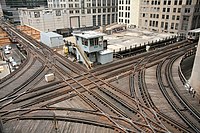Minimum railway curve radius

Okay, so imagine you have a toy train and you want to make it go around a curve. Now, the circle you draw for the train to go around has to have a certain size or radius. If the circle is too small, the train could derail or fall off the tracks.
Now, real trains that we see on tracks also need to have a minimum size for the curves they go around. This is called the minimum railway curve radius.
Think of it like this, if a train is going around a curve that is too small, the train could tip over or go off the tracks because it's moving too fast for how tight the curve is.
So, engineers and people who design railways figure out the minimum radius that a curve can be so that the train can go around it safely without tipping over.
This minimum radius depends on a few things like the speed the train is traveling, the weight of the train, and how long the train is. So, different trains traveling at different speeds might have different minimum curve radii.
Overall, the minimum railway curve radius is a safety measure to make sure trains can travel around curves without accidents happening.
Now, real trains that we see on tracks also need to have a minimum size for the curves they go around. This is called the minimum railway curve radius.
Think of it like this, if a train is going around a curve that is too small, the train could tip over or go off the tracks because it's moving too fast for how tight the curve is.
So, engineers and people who design railways figure out the minimum radius that a curve can be so that the train can go around it safely without tipping over.
This minimum radius depends on a few things like the speed the train is traveling, the weight of the train, and how long the train is. So, different trains traveling at different speeds might have different minimum curve radii.
Overall, the minimum railway curve radius is a safety measure to make sure trains can travel around curves without accidents happening.
Related topics others have asked about:
